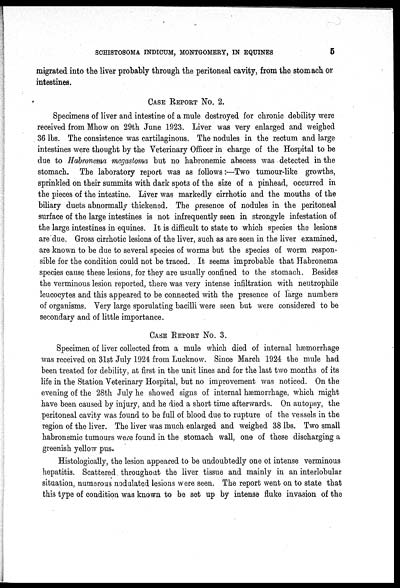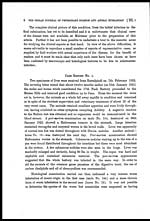Medicine - Veterinary > Veterinary colleges and laboratories > Indian journal of veterinary science and animal husbandry > Volume 3, 1933 > Original articles > Schistosoma indicum, Montgomery, 1906, as the cause of a persitant debility in equines in India, with a description of the lesions
(15) Page 5
Download files
Individual page:
Thumbnail gallery: Grid view | List view

SCHISTOSOMA INDICUM, MONTGOMERY, IN EQUINES 5
migrated into the liver probably through the peritoneal cavity, from the stomach or
intestines.
CASE REPORT NO. 2.
Specimens of liver and intestine of a mule destroyed for chronic debility were
received from Mhow on 29th June 1923. Liver was very enlarged and weighed
36 lbs. The consistence was cartilaginous. The nodules in the rectum and large
intestines were thought by the Veterinary Officer in charge of the Hospital to be
due to Habronema megastoma but no habronemic abscess was detected in the
stomach. The laboratory report was as follows:—Two tumour-like growths,
sprinkled on their summits with dark spots of the size of a pinhead, occurred in
the pieces of the intestine. Liver was markedly cirrhotic and the mouths of the
biliary ducts abnormally thickened. The presence of nodules in the peritoneal
surface of the large intestines is not infrequently seen in strongyle infestation of
the large intestines in equines. It is difficult to state to which species the lesions
are due. Gross cirrhotic lesions of the liver, such as are seen in the liver examined,
are known to be due to several species of worms but the species of worm respon-
sible for the condition could not be traced. It seems improbable that Habronema
species cause these lesions, for they are usually confined to the stomach. Besides
the verminous lesion reported, there was very intense infiltration with neutrophile
leucocytes and this appeared to be connected with the presence of large numbers
of organisms. Very large sporulating bacilli were seen but were considered to be
secondary and of little importance.
CASE REPORT NO. 3.
Specimen of liver collected from a mule which died of internal hæmorrhage
was received on 31st July 1924 from Lucknow. Since March 1924 the mule had
been treated for debility, at first in the unit lines and for the last two months of its
life in the Station Veterinary Hospital, but no improvement was noticed. On the
evening of the 28th July he showed signs of internal hæmorrhage, which might
have been caused by injury, and he died a short time afterwards. On autopsy, the
peritoneal cavity was found to be full of blood due to rupture of the vessels in the
region of the liver. The liver was much enlarged and weighed 38 lbs. Two small
habronemic tumours were found in the stomach wall, one of these discharging a
greenish yellow pus.
Histologically, the lesion appeared to be undoubtedly one of intense verminous
hepatitis. Scattered throughout the liver tissue and mainly in an interlobular
situation, numerous nodulated lesions were seen. The report went on to state that
this type of condition was known to be set up by intense fluke invasion of the
Set display mode to: Large image | Zoom image | Transcription
Images and transcriptions on this page, including medium image downloads, may be used under the Creative Commons Attribution 4.0 International Licence unless otherwise stated. ![]()
| Permanent URL | https://digital.nls.uk/75229295 |
|---|
| Description | Covers articles from 1933. |
|---|




